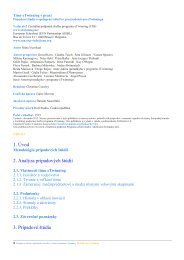Impact of data loggers on science teaching and learning - European ...
Impact of data loggers on science teaching and learning - European ...
Impact of data loggers on science teaching and learning - European ...
- No tags were found...
You also want an ePaper? Increase the reach of your titles
YUMPU automatically turns print PDFs into web optimized ePapers that Google loves.
<str<strong>on</strong>g>Impact</str<strong>on</strong>g> <str<strong>on</strong>g>of</str<strong>on</strong>g> <str<strong>on</strong>g>data</str<strong>on</strong>g> <str<strong>on</strong>g>loggers</str<strong>on</strong>g> <strong>on</strong> <strong>science</strong> <strong>teaching</strong> <strong>and</strong> <strong>learning</strong>Figure 16 to Figure 19 clearly show how the more pupils used different probes, the more theimpact <strong>on</strong> their interest, motivati<strong>on</strong> <strong>and</strong> ability to learn <strong>science</strong>s is positive. This is reas<strong>on</strong>able asusing a tool <strong>on</strong>ce can appear to be an out-<str<strong>on</strong>g>of</str<strong>on</strong>g>-c<strong>on</strong>text activity while the repeated use would havemore chances <str<strong>on</strong>g>of</str<strong>on</strong>g> getting the message across.EFFECT OF ACTIVITIES ACCORDING TO THE AGE OF PUPILSIn additi<strong>on</strong>, as we saw with Figure 5, the students could be divided between those under<strong>and</strong> those over the age <str<strong>on</strong>g>of</str<strong>on</strong>g> 14. Again, regardless <str<strong>on</strong>g>of</str<strong>on</strong>g> nati<strong>on</strong>ality, we looked at the post-activitiesviews depending, this time, <strong>on</strong> the pupils’ ages (see Figure 20 for the under-14 <strong>and</strong> Figure21 for the over-14s).Again, while the results per country were rather inc<strong>on</strong>clusive, as we saw with the probes,there is a clear corresp<strong>on</strong>dence between age <strong>and</strong> the perceived impact <str<strong>on</strong>g>of</str<strong>on</strong>g> using the probes.The results in Figure 20 <strong>and</strong> Figure 21 clearly show that the younger the pupils are, themore positive is the impact <strong>on</strong> their interest, motivati<strong>on</strong> <strong>and</strong> ability to learn <strong>science</strong>s.As we did not have students <str<strong>on</strong>g>of</str<strong>on</strong>g> each age group in all countries, the age dependence couldbe biased by the nati<strong>on</strong>ality (<strong>and</strong> therefore difference in attitude) <str<strong>on</strong>g>of</str<strong>on</strong>g> the pupils. For example,the UK pupils were both most positive <strong>and</strong> all bel<strong>on</strong>ging to the younger group (see Figure5 <strong>and</strong> Figure 15), while the majority <str<strong>on</strong>g>of</str<strong>on</strong>g> German pupils were both older <strong>and</strong> had morenegative views (Figure 5 <strong>and</strong> Figure 12), rendering the resulting image: younger equates tomore positive <strong>and</strong> older to less positive.To make sure the motivati<strong>on</strong>-age dependency is not a result <str<strong>on</strong>g>of</str<strong>on</strong>g> this nati<strong>on</strong>ality bias, wechecked the effect <str<strong>on</strong>g>of</str<strong>on</strong>g> the use <str<strong>on</strong>g>of</str<strong>on</strong>g> the probes depending <strong>on</strong> age in the case <str<strong>on</strong>g>of</str<strong>on</strong>g> the twocountries where we had students in both groups, namely France <strong>and</strong> Germany.In Figure 22 <strong>and</strong> Figure 23, we show the questi<strong>on</strong>naire results <str<strong>on</strong>g>of</str<strong>on</strong>g> the French pupils under<strong>and</strong> over 14 respectively <strong>and</strong> in Figure 24 <strong>and</strong> Figure 25, the same for the German pupils.By comparing the black <strong>and</strong> dark grey bars with the light grey <strong>and</strong> white bars, it isimmediately clear that in the German case the older the students are, the less effect theuse <str<strong>on</strong>g>of</str<strong>on</strong>g> probes has <strong>on</strong> their motivati<strong>on</strong>.To facilitate comparis<strong>on</strong>, we provide the average percentage <str<strong>on</strong>g>of</str<strong>on</strong>g> positive attitudes in each<str<strong>on</strong>g>of</str<strong>on</strong>g> the four cases in Table 5. As can be seen, in the French case the views appear to remainc<strong>on</strong>stant, while there is a clear decrease with age in the German case. On the other h<strong>and</strong>,when looking at the age peaks in the two age groups (see Figure 5) the French students29
















